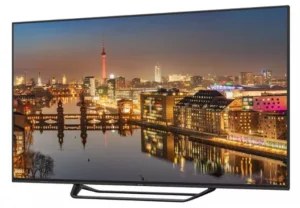Sharp created the mass LCD-TV market, mostly by selling LCD-TVs years before LCD technology was ready to support the application. The early Sharp LCD-TVs were truly terrible, in part because the LCDs of the time could not support video rates.

But when the technology matured sufficiently, Sharp was already there, commanding over 50% of the market for years. But then Sharp’s share fell below 50% and then ultimately fell to the low single digits, and then Sharp was gone from the North American TV market. (Cheapies with a licensed Sharp logo on them don’t count.) Now, Hon Hai is reintroducing Sharp as a premium brand with an “all-8K” product line, but the focus is on signage and professional A/V, although that wasn’t emphasized in Sharp’s booth at CES 2019.
Although Sharp left the North American TV Market, they maintained a strong presence in the signage and commercial markets, and it makes sense for Sharp to establish itself as a leader there, where an interest in 8K is just beginning to sprout.
At the forthcoming Digital Signage Expo (March 26-29 in Las Vegas), Sharp will show its existing 69.5-inch 8K display and the new 79.5-inch 8K that has a maximum peak white luminace of 4000 nits and the ability to receive 8K data through a single HDMI 2.1 cable, Sharp says.
Sharp’s 70-inch LV-70X500E 8K TV was introduced in Europe last year at an MSRP of €11,199. (Photo: Sharp)
The “All-8K” label at CES seems to be aspirational since Sharp features a variety of 4K pro A/V and consumer TVs on its website. The TVs are presumably Hisense TVs that carry the Sharp brand through a licensing agreement that Sharp’s parent Hon Hai tried and failed to break, claiming the Hisense sets were shoddy and were damaging the Sharp brand. The agreement expires in 2020. The smallest of the 4K TVs shown on the website is 43 inches, with prices straddling $400. That’s a lot of pixels per square inch.
At the moment 8 million pixels (4K) are cheap and 32 milllion pixels (8K) are expensive. Panel and monitor makers have to sell something with an appreciable margin, even if they only sell a few of them. (KW)
Analyst Comment
n Europe, to get around the licensing issue, Foxconn simply bought the licensing company – a simple solution. On the digital signage side, there has been a step change in dynamism and new product development since Sharp got the financial and supply chain resources from Foxconn.
Although Ken didn’t like the Sharp LCD TVs, there was a point, when the market was going HD, that Sharp developed panels that were lower resolution than HD for PAL TVs in Europe. They were pretty good and at the time, that TV was the first that I reviewed that I would have been prepared to trade for my Sony Trinitron CRT – mainly because of the reduced reflections from the LCD. However, the initiative was a marketing failure as retailers in Europe widely adopted the ‘HD Ready’ logo for sets that were at 720P (the Sharp sets were 540P, if I remember correctly), and the Sharp sets couldn’t carry the logo.
The reality was that most of the users that stayed with SD for a number of years would have been much better off with these sets, but the marketing triumphed over the technical logic and the sets disappeared from the market pretty quickly. (BR)
Ken Werner is Principal of Nutmeg Consultants, specializing in the display industry, manufacturing, technology, and applications, including mobile devices, automotive, and television. He consults for attorneys, investment analysts, and companies re-positioning themselves within the display industry or using displays in their products. He is the 2017 recipient of the Society for Information Display’s Lewis and Beatrice Winner Award. You can reach him at [email protected].

